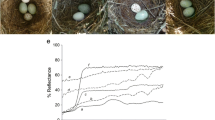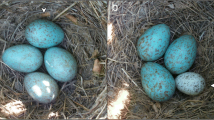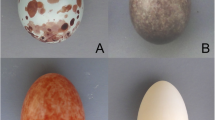Abstract
The recognition and subsequent rejection of brood parasite eggs is one of the most commonly observed defensive behaviors of the host. The brown-and-yellow marshbird (Pseudoleistes virescens) is a common host of the shiny cowbird (Molothrus bonariensis). This host recognizes and rejects immaculate white eggs of the cowbird, but accepts this bird’s spotted eggs. We assessed the acceptance threshold hypothesis which proposes that parasite egg recognition is context-dependent. We experimentally parasitized host nests with a spotted cowbird egg and simultaneously added: (1) one novel egg with spots similar to those of a cowbird egg but on a blue background or (2) one immaculate white cowbird egg. In this setting, 78 % of the novel blue egg with spots and 77 % of the cowbird’s immaculate white eggs were quickly recognized and rejected. The rejection frequency of spotted cowbird eggs was also high (60 %) and was not related to the type of egg which had been added to the host nest together with the spotted cowbird egg. This rejection frequency of spotted cowbird eggs is higher than the 21 % that we previously found in a similar experimental setting but in which the spotted cowbird egg was added singly to the host nest. These results support the acceptance threshold hypothesis that predicts an adaptive modulation of the antiparasite defence when the perceived risk of parasitism is high.



Similar content being viewed by others
References
Altmann J (1974) Observational study of behaviour: sampling methods. Behaviour 49:227–267
Bàn M, Moskàt C, Barta Z, Hauber ME (2013) Simultaneous viewing of own and parasitic eggs is not required for egg rejection by a cuckoo host. Behav Ecol 24:1014–1021
Barabás L, Gilicze B, Takasu F, Moskát C (2004) Survival and anti-parasite defense in a host metapopulation under heavy brood parasitism: a source–sink dynamic model. J Ethol 22:143–151
Briskie JV, Sealy SG, Hobson KA (1992) Defenses against avian brood parasites in sympatric and allopatric populations. Evolution 46:334–340
Davies NB (2000) Cuckoos, cowbirds and other cheats. T & AD Poyser, London
de la Colina MA, Pompilio L, Hauber ME, Reboreda JC, Mahler B (2012) Different recognition cues reveal the decision rules used for egg rejection by hosts of a variably mimetic avian brood parasite. Anim Cogn 15:881–889
Duré Ruiz NM, Fernández GJ, Mermoz ME (2008) Effects of cowbird parasitism in the brood reduction of the brown-and-yellow marshbird Pseudoleistes virescens. Condor 110:507–513
Gibson E (1918) Further ornithological notes from the neighbourhood of Cape San Antonio, province of Buenos Aires. Part I: Passeres. Ibis 60:363–415
Gloag R, Fiorini VD, Reboreda JC, Kacelnik A (2012) Brood parasite eggs enhance egg survivorship in a multiple parasitized host. Proc R Soc B 279:1831–1839
Gloag R, Fiorini VD, Reboreda JC, Kacelnik A (2013) The wages of violence: mobbing by mockingbirds as a frontline defence against brood-parasitic cowbirds. Anim Behav 86:1023–1029
Gloag R, Fiorini VD, Reboreda JC, Kacelnik A (2014) Shiny cowbirds share foster mothers but not true mothers in multiply parasitized mockingbird nest. Behav Ecol Sociobiol 68:681–689
Hauber ME, Sherman PW (2001) Self-referent phenotype matching: theoretical considerations and empirical evidence. Trends Neurosci 24:609–616
Hauber ME, Yeh PJ, Roberts JO (2004) Patterns and coevolutionary consequences of repeated brood parasitism. Proc R Soc B 271[Suppl]:S317–S320
Hauber ME, Moskát C, Bán M (2006) Experimental shift in hosts’ acceptance threshold of inaccurate-mimic brood parasite eggs. Biol Lett 2:177–180
Hauber ME, Samaš P, Anderson MG, Rutila J, Low J, Cassey P, Grim T (2014) Life-history theory predicts host behavioural responses to experimental brood parasitism. Ethol Ecol Evol 26:349–364
Hudson WH (1874) Notes on the procreant instincts of the three species of Molothrus found in Buenos Aires. Proc Zool Soc London 11:153–174
Jahn-Eimermacher A, Lasarzik I, Raber J (2011) Statistical analysis of latency outcomes in behavioural experiments. Behav Brain Res 221:271–275
Spottiswoode CN, Kilner RM, Davies NB (2012) Brood parasitism. In: Royle NJ, Smiseth PT, Kölliker M (eds) The evolution of parental care. Oxford University Press, Oxford, pp 226–243
Kilner RM, Langmore NE (2011) Cuckoos versus hosts in insects and birds: adaptations, counter-adaptations and outcomes. Biol Rev 86:836–852
Krüger O (2007) Cuckoos, cowbirds and hosts: adaptations, trade-offs and constraints. Phil Trans R Soc B 362:1873–1886
Liebert A, Starks PT (2004) The action component of recognition systems: a focus on the response. Ann Zool Fenn 41:747–764
Lotem A, Nakamura H, Zahavi A (1995) Constraints on egg discrimination and cuckoo-host co-evolution. Anim Behav 49:1185–1209
Lowther P (2013) Lists of victims and hosts of the parasitic cowbird (Molothrus). Available at: http://fieldmuseum.org/sites/default/files/Molothrus_hosts-26aug2013.pdf
Mahler B, Confalonieri VA, Lovette IJ, Reboreda JC (2008) Eggshell spotting in brood parasitic shiny cowbird (Molothrus bonariensis) is not linked to the female sex chromosome. Behav Ecol Sociobiol 62:1163–1169
Mason P (1986) Brood parasitism in a host generalist, the shiny cowbird: I. The quality of different species as hosts. Auk 103:52–60
Mermoz ME, Reboreda JC (1994) Brood parasitism of the shiny cowbird, Molothrus bonariensis, on the brown-and-yellow marshbird, Pseudoleistes virescens. Condor 96:716–721
Mermoz ME, Reboreda JC (1998) Nesting success in brown-and-yellow marshbirds: effects of timing, nest site and brood parasitism. Auk 115:871–878
Mermoz ME, Reboreda JC (1999) Egg-laying behaviour by shiny cowbirds parasitizing brown-and-yellow marshbirds. Anim Behav 58:873–882
Mermoz ME, Reboreda JC, Fernández GJ (2013) High rates of shiny cowbird parasitism on brown-and-yellow marshbird select for complementary host defenses. Condor 115:910–920
Moksnes A (1992) Egg recognition in chaffinches and bramblings. Anim Behav 44:993–995
Moksnes A, Røskaft E, Korsnes L (1993) Rejection of cuckoo (Cuculus canorus) eggs by meadow pipits (Anthus pratensis). Behav Ecol 4:120–127
Moskát C, Hauber ME (2007) Conflict between egg recognition and egg rejection decisions in common cuckoo (Cuculus canorus) hosts. Anim Cogn 10:377–386
Moskát C, Székely T, Kisbenedek T, Karcza Z, Bártol I (2003) The importance of nest cleaning in egg rejection behaviour of great reed warblers Acrocephalus arandinaceas. J Avian Biol 34:16–19
Moskát C, Székely T, Cuthill IC, Kisbenedek T (2008) Hosts’ responses to parasitic eggs: which cues elicit hosts’ egg discrimination? Ethology 114:186–194
Moskát C, Bán M, Székely T, Komdeur J, Lucassen RWG, van Boheemen AL, Hauber ME (2010) Discordancy or template based recognition? Dissecting the cognitive basis of the rejection of foreign eggs in hosts of avian brood parasites. J Exp Biol 213:1976–1983
Øien IJ, Moksnes A, Røskaft E, Honza M (1998) Costs of cuckoo Cuculus canorus parasitism to reed warblers Acrocephalus scirpaceus. J Avian Biol 29:209–215
Orians GH (1980) Some adaptations of marsh-nesting blackbirds. Princeton University Press, Princeton
Peer BD, Sealy SG (2004) Correlates of egg rejection in hosts of the brown-headed cowbird. Condor 106:580–599
Peer BD, Robinson SK, Herkert JR (2000) Egg rejection by cowbird hosts in grasslands. Auk 117:892–901
Petrie M, Møller AP (1991) Laying eggs in other’s nests: intraspecific brood parasitism in birds. Trends Ecol Evol 6:315–320
Reboreda JC, Mermoz ME, Massoni V, Astié AA, Rabufetti FL (2003) Impacto del parasitismo de cría del Tordo Renegrido (Molothrus bonariensis) sobre el éxito reproductivo de sus hospedadores. Hornero 18:77–88 (in Spanish)
Reeve H (1989) The evolution of conspecific acceptance thresholds. Am Nat 133:407–435
Ridgely RS, Tudor G (1989) The birds of South America, vol. 1: the oscine passerines. University of Texas Press, Austin
Røskaft E, Takasu F, Moksnes A, Stokke BG (2006) Importance of spatial habitat structure on establishment of host defenses against brood parasitism. Behav Ecol 17:701–708
Rothstein SI (1974) An experimental and teleonomic investigation of avian brood parasitism. Condor 77:250–271
Rothstein SI (1975) Mechanisms of avian egg-recognition: do birds know their own eggs? Anim Behav 23:268–278
Rothstein SI (1982) Mechanisms of avian egg recognition: which egg parameters elicit responses by rejecter species? Behav Ecol Sociobiol 11:229–239
Rothstein SI, Robinson SK (1998) The evolution and ecology of avian brood parasitism. In: Rothstein SI, Robinson SK (eds) Parasitic birds and their hosts. Oxford University Press, New York, pp 3–56
Sackmann P, Reboreda JC (2003) A comparative study of shiny cowbird parasitism in two large hosts: chalk-browed mockingbird and rufous-belied thrush. Condor 105:728–736
Samaš P, Hauber ME, Cassey P, Grim T (2011) Repeatability of foreign egg rejection: testing the assumptions of co-evolutionary theory. Ethology 117:606–619
Scardamaglia RC, Reboreda JC (2014) Ranging behavior of female and male shiny cowbirds and screaming cowbirds while searching for host nests. Auk 131:610–618
Sealy SG (1995) Burial of cowbird eggs by parasitized yellow warblers: an empirical and experimental study. Anim Behav 49:877–889
Sealy SG, Bazin RC (1995) Low frequency of observed cowbird parasitism on Eastern Kingbirds: host rejection, effective nest defense, or parasite avoidance? Behav Ecol 6:140–145
Sealy SG, Neudorf DL, Hobson KA, Gill SH (1998) Nest defense by potential hosts of the brown-headed cowbird. In: Rothstein SI, Robinson SK (eds) Parasitic birds and their hosts. Oxford University Press, New York, pp 194–211
Stokke BG, Hafstad I, Rudolfsen G, Moksnes A, Møller AP, Røskaft E, Soler M (2008) Predictors of resistance to brood parasitism within and among reed warbler populations. Behav Ecol 19:613–620
Takasu F (1998) Why do all host species not show defense against avian brood parasitism: evolutionary lag or equilibrium? Am Nat 151:193–205
Acknowledgments
We thank M. Beade, and M. Busai for logistical support at the study area. We especially thank V. Ferretti for comments on an earlier version of this manuscript for checking the English grammar. Daniel Hanley and an anonymous reviewer provided useful comments to a previous version of the manuscript. This study was supported by grants from the Consejo Nacional de Investigaciones Científicas y Técnicas of Argentina (PIP112-200901-00011 to GJF and PICT 11420100100016 to MEM).
Author information
Authors and Affiliations
Corresponding author
About this article
Cite this article
Mermoz, M.E., Haupt, C. & Fernández, G.J. Brown-and-yellow marshbirds reduce their acceptance threshold of mimetic brood parasite eggs in the presence of non-mimetic eggs. J Ethol 34, 65–71 (2016). https://doi.org/10.1007/s10164-015-0447-3
Received:
Accepted:
Published:
Issue Date:
DOI: https://doi.org/10.1007/s10164-015-0447-3




